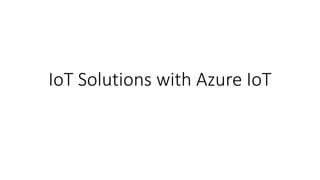MVP-IoTSolutionsWithAureIoT_v1.2.pptx
- 1. IoT Solutions with Azure IoT
- 2. IoT solutions ŌĆó IoT is not only about devices/hardware ŌĆó IoT solutions: ŌĆó Device Management (provisioning, security, updates, configurations, etc) ŌĆó Bidirectional device integration (D2C, C2D) ŌĆó Data collection ŌĆó Data controls, transformation, projections, pre-processing/processing, enrichment, mappings ŌĆó Storage (multi-format and multi-system) ŌĆó Data usage, analysis, AI, integration/exposition, monetization, etc ŌĆó Intelligence or value extraction
- 3. Architectures ŌĆó No generic ŌĆ£perfectŌĆØ answer ŌĆó Depend always on requirements: ŌĆó Functional ŌĆó Technical ŌĆó Business ŌĆó Key factors (no specific order): ŌĆó Latency ŌĆó Flows (bidirectional, long/short, reactive, etc) ŌĆó Value (data, intelligence, processing, AI, etc) ŌĆó Security ŌĆó Scalability ŌĆó Reliability ŌĆó Cost ŌĆó Business model(s) ŌĆó Evolutivity ŌĆó Technical debt level
- 4. Architectures ŌĆō satellite view
- 6. IoT Solutions with Azure IoT ŌĆó Azure IoT Hub ŌĆó Azure IoT Hub DPS ŌĆó Azure Device Update for IoT Hub ŌĆó Azure Digital Twins ŌĆó Azure IoT Central ŌĆó Azure Plug and Play ŌĆó Azure Sphere ŌĆó Azure IoT Edge ŌĆó AKS Essentials for Edge ŌĆó K3S ŌĆó E4K ŌĆó Azure Defender for IoT ŌĆó Azure Event Hub ŌĆó Azure Event Grid ŌĆó Azure Service Bus Topic ŌĆó Azure Service Bus Queue ŌĆó Azure Stream Analytics ŌĆó Azure Functions ŌĆó Azure App Services ŌĆó Azure Kubernetes Services ŌĆó Azure Container Application ŌĆó Azure API Management ŌĆó Azure Data Explorer ŌĆó Azure SQL Database Family (including MySQL and PostgreSQL) ŌĆó Azure Cosmos DB (including PostgreSQL) ŌĆó Azure Databricks ŌĆó Azure Synapse ŌĆó Azure Storage ŌĆó Azure Machine Learning ŌĆó Azure OpenAI ŌĆó Azure Cognitive Services ŌĆó Azure Monitor ŌĆó Azure Application Insights ŌĆó Azure Log Analytics ŌĆó Azure Advisor ŌĆó Azure Arc ŌĆó Azure App Configuration ŌĆó Azure Key Vault ŌĆó Azure Defender for IoT ŌĆó Azure Defender for API ŌĆó Azure Defender ŌĆó Azure Sentinel ŌĆó Azure Vnet ŌĆó Azure Private Endpoints / Service Endpoints ŌĆó Azure Frontdoor ŌĆó Azure Application Gateway ŌĆó Azure Firewall ŌĆó Azure Private DNS ŌĆó Azure Sentinel
- 7. DPS and IoT Hub ŌĆó DPS ŌĆó Provisioning / reprovisioning ŌĆó Configurations by default ŌĆó Security (SAS, X509 | unique, group enrollments) ŌĆó IoT Hub ŌĆó Device identity (or module) ŌĆó D2C/C2D (ou M2C/C2M) with Device Twin (tags, desired properties and reported properties), messages and commands ŌĆó Routes / Endpoints + Enrichments ŌĆó Updates ŌĆó Jobs
- 8. Digital Twins ŌĆó Digital representation of a logic or physical entity. ŌĆó Generic concept. ŌĆó Not a Device Twin. Common mistake. ŌĆó Azure Digital Twins relies on DTDL, which describes: ŌĆó Properties ŌĆó Telemetries ŌĆó Commands ŌĆó Relations ŌĆó Differenciator key points of ADT: ŌĆó Search engine (graph) ŌĆó Routes and endpoints
- 9. Questions









